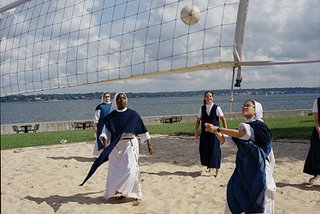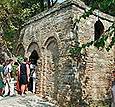
 Today's Nun Has A Veil--And A Blog
More young women are entering convents.
Today's Nun Has A Veil--And A Blog
More young women are entering convents. How they are changing the sisterhood
By TRACY SCHMIDT, LISA TAKEUCHI CULLEN
Posted Monday, Nov. 13, 2006
For the iPod generation, it doesn't get more radical than wearing a veil. The hijab worn by traditional Muslim women might have people talking, but it's the wimple that really turns heads. And in the U.S. today, the nuns most likely to wear that headdress are the ones young enough to have a playlist.
Over the past five years, Roman Catholic communities around the country have experienced a curious phenomenon: more women, most in their 20s and 30s, are trying on that veil. Convents in Nashville, Tenn.; Ann Arbor, Mich.; and New York City all admitted at least 15 entrants over the past year and fielded hundreds of inquiries. One convent is hurriedly raising funds for a new building to house the inflow, and at another a rush of new blood has lowered the median age of its 225 sisters to 36. Catholic centers at universities, including Illinois and Texas A&M, report growing numbers of women entering discernment, or the official period of considering a vocation. Career women seeking more meaning in their lives and empty-nest moms are also finding their way to convent doors.
This is a welcome turnabout for the church. As opportunities opened for women in the 1960s and '70s, fewer of them viewed the asceticism and confinements of religious life as a tempting career choice. Since 1965, the number of Catholic nuns in the U.S. has declined from 179,954 to just 67,773, according to the Center for Applied Research in the Apostolate at Georgetown University. The average age of nuns today is 69. But over the past decade or so, expressing their religious beliefs openly has become hip for many young people, a trend intensified among Catholic women by the charismatic appeal of Pope John Paul II's youth rallies and his interpretation of modern feminism as a way for women to express Christian values.
As this so-called JP2 generation has come of age, religious orders have begun to reach out again to young people--and to do so in the language that young people speak. Convents conduct e-mail correspondence with interested women, blogs written by sisters give a peek into the habited life and websites offer online personality questionnaires to test vocations. One site, Vocation-network.org frames the choice much like a dating service, with Christ as the ultimate match. "For a long time, we neglected to invite people to see what we are about," says Sister Doris Gottemoeller of the Institute of the Sisters of Mercy of America, a national order. "I think we're more ready to do that now."
And although the extreme conservatism of a nun's life may seem wholly countercultural for young American women today, that is exactly what attracts many of them, say experts and the women themselves. "Religious life itself is a radical choice," says Brother Paul Vednarczyk, executive director of the National Religious Vocation Conference in Chicago. "In an age where our primary secular values are sex, power and money, for someone to choose chastity, obedience and poverty is a radical statement."
That radicalism is, ironically, embodied by the wearing of the veil. Decreed unnecessary by Vatican II and shed happily by many older nuns, the headdress is for many of today's newcomers a desired accessory. "A lot of my older sisters would never wear the veil," says Sister Sarah Roy, 29, who is the only member of her Sisters of St. Francis of the Immaculate Conception in Peoria, Ill., to do so. (The others wear a simple dark dress adorned by a pin.) Though she admits "people just stare at you like you're a freak," she adds, "It's a trend with younger women wanting to wear the veil now."
Newer nuns see the veil as a public expression of faith, says Cheryl Reed, author of Unveiled: Inside the Hidden Lives of Nuns. "You can understand why a woman who has given up sex, freedom and money would want to wear her wedding dress--which is what they consider their habits to be. You want to say, 'I'm special. I gave this up.'"
Katharine Johnson isn't sure yet which wedding dress she will choose--a white one or a black one. At 21, she is in her third year of discernment. For now the senior at the University of Illinois at Urbana-Champaign dresses as her classmates do, though on her ring finger she wears a miniature rosary and a favorite T shirt reads, EVERYONE LOVES A CATHOLIC GIRL. She still dates but limits physical contact to kissing. "As I date men and I date convents, I am waiting for God to say, 'This is where your heart belongs,'" she says.
Becoming a nun typically takes seven to nine years. After the period of discernment, a woman enters a religious community as a postulant, and she reflects upon her vocation and helps with chores around the convent. At the end of what is primarily a yearlong spiritual retreat, the postulant and her advisers in the community decide whether she will become a novice and study Catholic theology and ministry for up to two years. She may then take her temporary vows. After an additional four to eight years during which she serves the convent's mission, she makes her final vows and becomes a professed nun.
At the Sisters of Life Formation House in the Bronx, N.Y., 16 young women are making their way through that journey. They include a former Marine, a professional opera singer, a United Nations aide and a recent Yale grad. They have left behind paychecks, apartments, even boyfriends. Sister Thérèse Saglimbeni, 27, a novice who joined the convent in 2005, recalls watching the sisters playing volleyball while she was a student at the nearby State University of New York Maritime College. "I was with my boyfriend and had said how fun the sisters looked," she says. "He said, 'Well, why don't you join them?' And I replied, 'Well, maybe I will!'"
The other sisters chuckle when Saglimbeni recounts her saucy retort. But many of their loved ones feel less jovial about the women's decision to take the veil. "For those who are called, there is a real falling in love. You are filled with a joy and desire to be with God," says Sister Mary Gabriel Devlin, 32, vocation director at Sisters of Life. "Their families are not experiencing this, so it can be hard for them to understand." The sense of alienation can be even greater when women choose an order that isolates them from their families and others so that they can devote themselves to strict schedules of regimented prayer. Convents like Sisters of Life that combine contemplation with active ministry to the public are the most popular among young women.
While the JP2 generation seeks order and community, Gen Xers are coming to religious life in a quest for meaning after secular society has failed to meet their needs. "It's been my experience that women who are older--in their 30s and early 40s--feel that they've accomplished a lot with their life, but there's still something missing," says Sister Laurie Brink, 45, a professor of biblical studies at the Catholic Theological Union in Chicago who has lectured on the subject and who took her vows at 37. Her generation, she adds, growing up in the wake of Vatican II, was not as schooled in catechism as were baby boomers and millennials. Many also broke from the church when their parents divorced. "My generation," says Brink, "is not good with commitment because we haven't seen a lot of it."
Now they're finding a sense of wholeness by binding themselves to their faith. Sister Melissa Schreifels, 37, first considered becoming a nun when a teacher at her high school in St. Cloud, Minn., suggested it. Because it seemed that "nobody was doing that anymore," Schreifels attended college and launched a career as a pharmacist, volunteering at her church, a hospital library and a pregnancy crisis center in her spare time. "But there was just an emptiness inside that doing the volunteer work and the pharmacy work didn't fill in me," she says. When a pastor again suggested sisterhood, Schreifels reconsidered. In 2003 she joined the School Sisters of Notre Dame in Mankato, Minn., who do not mandate a habit or discourage her from continuing to work as a pharmacist for Target. Schreifels gave up her Subaru Forester and apartment and moved into a house with the sisters, but her work is considered part of the order's mission to serve the community; her salary goes to support the sisterhood. "I am open to whatever God is asking," says Schreifels.
Although Bea FitzGerald, 66, first heard the call as a young woman, she pushed it aside to raise her seven children. After her husband left in 1968, she put herself through school and supported her family as a registered nurse. Once her children were grown, the call grew louder. She obtained an annulment, joined the Sisters of Charity of Nazareth, based in Louisville, Ky., and, at 51, became one of the growing number of so-called Sister Moms. While widowed or divorced women with grown children have long entered religious life, Sister Moms in the U.S. are now establishing a distinct identity for themselves. Spurred by a dissertation project for her Ed.D. at Spalding University, FitzGerald tracked down 125 of them in 98 religious communities around the country. In the 1990s, she began an annual conference at which the women bond over such unique experiences as telling their children about their choice ("98% are supportive," says FitzGerald).
Nuns of all ages at convents in the U.S. say modern technology is helping them give the world--and prospective applicants--a more realistic picture of their lives. "There are people out there who wonder what being a nun is like," says Sister Julie Vieira, 36. "These are people who were exposed to stereotypes of nuns and don't understand how we really live." So last summer Vieira began a blog titled A Nun's Life, in which she has chronicled her days as a sister of the Immaculate Heart of Mary and also a conventional-dressing, apartment-dwelling, master's degree--holding production coordinator at the Loyola Press, a Catholic publisher in Chicago. "Being a nun has not always been my lifelong goal," she writes in one entry. "The whole 'nun' thing kind of snuck up on me when I wasn't paying much attention ... I can't tell you how many times I've been called 'Sister Julie' that it doesn't jolt me or make me look around and wonder who they are talking about."
Sister Joseph Andrew Bogdanowicz, vocation director at the Dominican Sisters of Mary, Mother of the Eucharist in Ann Arbor, credits e-mail to some extent with what can only be described as her order's astonishing growth. Founded in 1997 as an offshoot of a large convent, the Sisters now have 73 members with an average age of 24. In 2006, 15 women entered as postulants. Next August, more than 20 women are scheduled to join them. The order is fund raising for a new convent for them to live in. "We cannot build fast enough. It's incredible," says Bogdanowicz, 50.
The Franciscan Sisters of Christian Charity, whose average age is 70, are seeking a similar youth infusion. The order, based in Mantiowac, Wis., hired a marketing company from nearby Milwaukee to hold focus groups on college campuses around the state. The marketers then launched a website featuring a blog written by the nuns, along with a slickly produced podcast about a young nun joining the order.
There's also a downloadable song of the month donated by a Christian artist, in response to the focus groups' revelation that "music was one of the highest ways to communicate with" young people, says vocation director Sister Julie Ann Sheahan. Thus the order's radio and TV ads feature a theme song based on a Franciscan hymn. The tune is also available on the website as a ringtone. Its title: Called to Be.
Read profiles of new nuns and link to their blogs and websites at time.com
Have you any thoughts on this?












